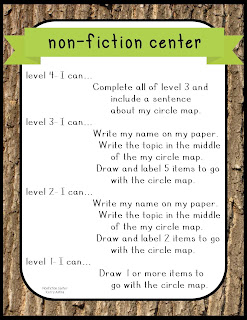So how do you take non-literate children and expect them to create anything meaningful at a non-fiction center? Let's start with circle thinking maps. My class has done several circle thinking maps as class through Alphabet Boot Camp. So my students were already very familiar with creating them. We created some class samples and talked about my grading expectations.
I have supplied the center with lots of books on particular topics; sorted into bins. These bins will be changed out about once a month (or when I see interest in a particular topic dwindling). With these books students are learning to look for captions or scan the text to find the words to label their pictures. (MOST of my students are not there yet.)
For students in need of more support, I have also included vocabulary pages (in a small binder in page protectors). Now, everyone who is able to copy words can be successful at creating their circle map.
I opened this center just a short 2 weeks ago and I had a kid (not even from my highest reading group) create a level 4 paper!!!!! Can you say proud teacher???
So where do I go from here? All the older maps will still be available for students to continue to work on; but I will be introducing new ones as the year goes on. Here is what I am thinking my yearly timeline might look like...
For the next few months I will continue to let my students work on circle maps and help them develop stronger sentences.
December-January- In order to write a paragraph on one topic, students will need a narrower view. I will introduce a bubble map. With this map students will need to be able to read a book on one particular topic. (Here I am expecting them to be early readers an be able to pull information from a simple text.) Students will use the center of the bubble map to write their topic and then use the bubbles for details or adjectives. From their bubble maps students can write a sentence and start writing paragraphs.
March- April- In the Spring I will introduce sequencing and the use of flow maps. The books I put into the non-fiction center will be deliberate choices- life cycles and how things are made. At this point, most students will be able to read and comprehend the simple texts. Students will be able to use their flow map to write a paragraph on their chosen topic.
What are you thoughts or suggestions about this center? What is something you do in your classroom to get your students working with non-fiction?









Love this! My kinders love animals! Jilliancollura@gmail.com
ReplyDeleteThank you! Enjoy!
DeleteMy students love nonfiction-especially animals and I try to add to my collection of easy nonfiction books each school year. The boys go for nonfiction first when it is times to read! I usually have some sentence scaffolds for students to use when writing. skk.worth@gmail.com
ReplyDeleteYeah, my students love non-fiction as well! Good idea about the sentence scaffolds. Thanks for your comments and enjoy!
DeleteKids love animals. This is such a great activity.
ReplyDeleteHeathermphillips4@gmail.com
Thank you! Enjoy!
DeleteThis is my first year in kindergarten. These would be a great addition to our different units about animals. These look great!
ReplyDeleteLanel@milton-union.k12.oh.us
Welcome to Kindergarten! I hope you are enjoying it! I'm glad you'll find these useful. :)
DeleteI love the look of this resource and it is perfect as I plan to do an ocean topic soon with my class.
ReplyDeletesquintyseam@gmail.com
My kinders would love this!!!
ReplyDeletemarylove.houston@gmail.com
My students are always engaged whenever we talk about animals. :)
DeleteI'm glad they will enjoy this! Thank you!
DeleteI am always looking for resources with ocean themes... especially ocean animals! Kaf43@aol.com
ReplyDeleteGreat! Enjoy!
DeleteI love nonfiction! This looks so appealing! Abchady1@aol.com
ReplyDeleteThank you! Enjoy!
Deletebrooke.mccorkle@gmail.com
ReplyDeleteWould love this!
ReplyDeletetinysmiles34@gmail.com
We start our non fiction writing in Dec with learning about polar animals. We use thinking maps as well and the tree map specifically for sentence writing. We write the animal on the top line and can, have, are (or whatever word makes sense) on each of the three branches. Does that make sense? So one sentence for each branch on polar bears might read: Polar bears are white. Polar bears (they) have black skin. Polar bears (they) can swim.
ReplyDeleteYour cards look great! :) lorepuckett at gmail dot com
I love the idea of using tree maps to organize non-fiction writing. I think I will have to make the space to teach them and throw it into this center! Thank you for your thoughts! Enjoy!
DeleteLook great! I need this for my class. atozteacher@gmail.com
ReplyDeleteThank you! Enjoy!
DeleteIt turned out great Kerry - thanks for sharing that you were inspired by my non-fiction literacy center. I look forward to seeing what your students are capable of doing as the year goes on. **Here's to working smart** and creating year-long literacy centers!
ReplyDelete- Leslie
-Leslie
TeachJunkie.com
KindergartenWorks.com
Thank you for the inspiration! I'll keep you updated!
Delete